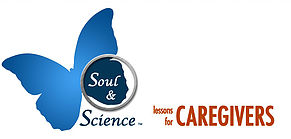BOOKS

Reminiscence and Life Story Work, Fourth Edition
―Faith Gibson, 2011
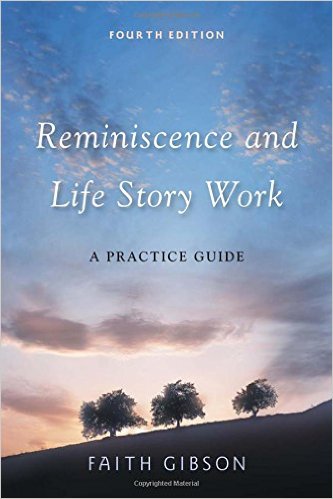 Reminiscence is a valuable tool for the professional carer as well as those who are looking after a family member or friend. It enhances and enriches the care relationship, and benefits both the person being cared for and the carer. This fully-updated fourth edition is full of practical information on planning and running successful reminiscence work. It will enable carers and health and social care practitioners to develop the attitude, knowledge, understanding, values and skills they need to use reminiscence with people of all ages, either individually or in groups, and in residential or community settings. Topics covered include reminiscence with individuals and couples, inter-generational reminiscence, reminiscence with individuals from minority ethnic groups and reminiscence with people with sensory and learning disabilities, dementia, depression and terminal illness. This book is the ideal starting point for any professional taking up reminiscence work, as well as for those who wish to deepen their knowledge and increase their ability to help those they care for in less formal ways.
Reminiscence is a valuable tool for the professional carer as well as those who are looking after a family member or friend. It enhances and enriches the care relationship, and benefits both the person being cared for and the carer. This fully-updated fourth edition is full of practical information on planning and running successful reminiscence work. It will enable carers and health and social care practitioners to develop the attitude, knowledge, understanding, values and skills they need to use reminiscence with people of all ages, either individually or in groups, and in residential or community settings. Topics covered include reminiscence with individuals and couples, inter-generational reminiscence, reminiscence with individuals from minority ethnic groups and reminiscence with people with sensory and learning disabilities, dementia, depression and terminal illness. This book is the ideal starting point for any professional taking up reminiscence work, as well as for those who wish to deepen their knowledge and increase their ability to help those they care for in less formal ways.
Where To Go From Here
– Dr. James E. Birren, 2012
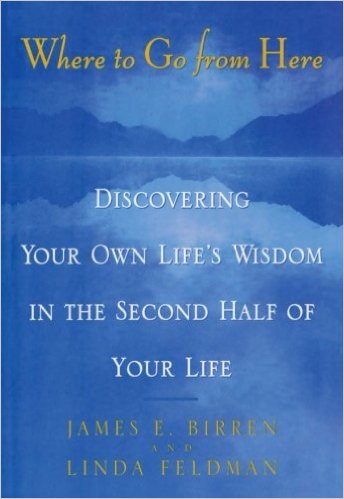 Jim Birren, the pioneer of guided autobiography, has developed a remarkable process that encourages people to take stock of their lives so that they can move forward, reinvigorated, into a vital, rewarding future.”I want you to think of your life as an autobiographical story with a past, present, and a future yet to be plotted”, Jim Birren writes, as he urges readers to appreciate all they’ve been through, survived, and accomplished; figure out what is missing; and decide how they want to spend the rest of their lives.By contemplating our lives, or telling our stories in small groups where other people’s memories prime our own, we can increase the chances of getting the most return from the years ahead. Cautioning that there is no magic carpet ride to a blissful elderhood, Jim Birren offers readers the ability to let go of the fears from the past, to understand and be themselves, and to see the future as a wonderful adventure. The result is living longer better.
Jim Birren, the pioneer of guided autobiography, has developed a remarkable process that encourages people to take stock of their lives so that they can move forward, reinvigorated, into a vital, rewarding future.”I want you to think of your life as an autobiographical story with a past, present, and a future yet to be plotted”, Jim Birren writes, as he urges readers to appreciate all they’ve been through, survived, and accomplished; figure out what is missing; and decide how they want to spend the rest of their lives.By contemplating our lives, or telling our stories in small groups where other people’s memories prime our own, we can increase the chances of getting the most return from the years ahead. Cautioning that there is no magic carpet ride to a blissful elderhood, Jim Birren offers readers the ability to let go of the fears from the past, to understand and be themselves, and to see the future as a wonderful adventure. The result is living longer better.
Living Your Unlived Life: Coping with Unrealized Dreams and Fulfilling Your Purpose in the Second Half of Life
– Robert A. Johnson, Jerry Ruhl, 2009
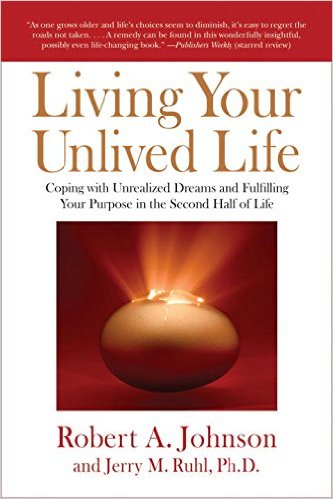 The esteemed Jungian psychologist counsels on how to cope with feelings of failure or regret in the latter half of life and how to open to a more meaningful existence, even if outer circumstances cannot be changed.
The esteemed Jungian psychologist counsels on how to cope with feelings of failure or regret in the latter half of life and how to open to a more meaningful existence, even if outer circumstances cannot be changed.
In Living Your Unlived Life, the renowned therapist Robert A. Johnson, writing with longtime collaborator and fellow Jungian psychologist Jerry M. Ruhl, offers a simple but transformative premise: Our abandoned, unrealized, or underdeveloped talents, when they are not fully integrated into our lives, can become profoundly troublesome in midlife, leading us to depression, suddenly hating our spouses, our jobs, or even our lives. When our unlived lives are brought to consciousness, however, they can become the fuel that can propel us beyond our limitations, even if our outer circumstances cannot always be visibly altered.
The Handbook of Structured Life Review
―Barbara K. Haight, Barrett S. Haight, 2007
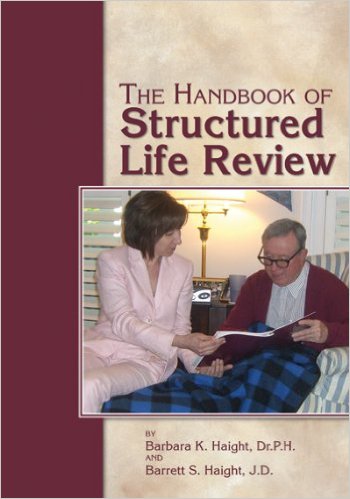 Clear and concise, this practical handbook synthesizes 30 years of research and practice using the Structured Life Review process. This approach is a one-on-one therapeutic technique that guides people in reflecting on their lives from early childhood to the present. It allows individuals to learn from past experiences, settle unresolved issues, and ultimately achieve a state of life acceptance. Participants benefit from increased life satisfaction, reduced depression, and the opportunity for reconciliation, acceptance, and serenity.Developed originally for older adults, Structured Life Review is appropriate for people of all ages. It is especially beneficial for individuals experiencing stress, undergoing major change, or coping with grief or a traumatic event.
Clear and concise, this practical handbook synthesizes 30 years of research and practice using the Structured Life Review process. This approach is a one-on-one therapeutic technique that guides people in reflecting on their lives from early childhood to the present. It allows individuals to learn from past experiences, settle unresolved issues, and ultimately achieve a state of life acceptance. Participants benefit from increased life satisfaction, reduced depression, and the opportunity for reconciliation, acceptance, and serenity.Developed originally for older adults, Structured Life Review is appropriate for people of all ages. It is especially beneficial for individuals experiencing stress, undergoing major change, or coping with grief or a traumatic event.
Following this user-friendly handbook, Structured Life Review sessions can be easily led by professionals and nonprofessionals alike: social workers, counselors, activity staff, or even volunteers. The book thoroughly explains the role of the Therapeutic Listener and describes useful counseling and communication techniques. Step-by-step goals, instructions, and sample dialogue for eight separate sessions provide a blueprint for conducting life reviews. Handy appendices include assessment tools and a Life Review Form with recommended questions for each session.
Telling the Stories of Life through Guided Autobiography Groups
―James E. Birren, Kathryn N. Cochran, 2001
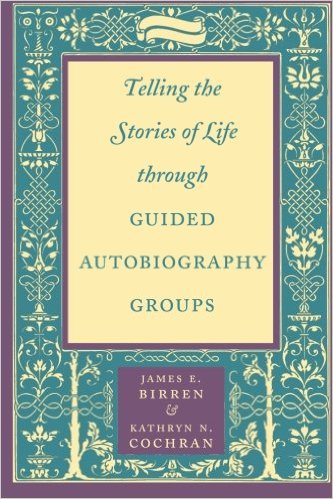 Telling the Stories of Life through Guided Autobiography Groups, based on James Birren’s 25 years of conducting autobiography groups, discusses all the topics an organizer faces while developing a program for adults who want to recall and write down their life histories. This book is ideal for adult education programs, church groups, social workers, psychologists, gerontologists, and others who work with adults who might be interested in exploring, recording, or sharing their personal histories. It helps professionals and trained workshop leaders at community centers, senior centers, schools and other settings guide group participants in exploring major themes of their lives so that they can organize and write their stories and share them in a group with others on the same journey. This exercise is rewarding for adults of any age in a period of transition or with interest in gaining insight from their own stories. Personal development and a feeling of connection to other participants and their stories is a natural outcome of this process. This book provides background material and detailed lesson plans for those who wish to develop and lead an autobiography group.
Telling the Stories of Life through Guided Autobiography Groups, based on James Birren’s 25 years of conducting autobiography groups, discusses all the topics an organizer faces while developing a program for adults who want to recall and write down their life histories. This book is ideal for adult education programs, church groups, social workers, psychologists, gerontologists, and others who work with adults who might be interested in exploring, recording, or sharing their personal histories. It helps professionals and trained workshop leaders at community centers, senior centers, schools and other settings guide group participants in exploring major themes of their lives so that they can organize and write their stories and share them in a group with others on the same journey. This exercise is rewarding for adults of any age in a period of transition or with interest in gaining insight from their own stories. Personal development and a feeling of connection to other participants and their stories is a natural outcome of this process. This book provides background material and detailed lesson plans for those who wish to develop and lead an autobiography group.
The authors explain the concept of guided autobiography, discuss the benefits to the group participants, and provide logistical information on how to plan, organize, and set up a group. An appendix provides exercises, handouts, and suggested adaptations for specific groups. The book also explains a systematic method of priming memories, including the history of family and of one’s life work, the role of money, health and the body, and ideas about death.
At a time when rapid change has created a widespread yearning to write down and exchange personal accounts, sharing life stories can reveal a great deal about how we have come to be the persons we are. Telling the Stories of Life through Guided Autobiography Groups shows how to organize, record, and share life experiences through a proven and effective technique.
Guiding Autobiography Groups for Older Adults: Exploring the Fabric of Life
―James E. Birren, Donna E. Deutchman, 1991
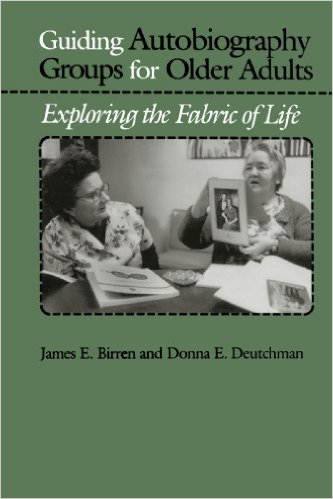 “Guided autobiography,” write the authors, “is ideally suited to foster in the older adult a belief that his or her life is meaningful and something of which to be proud.” This book helps professionals―at senior centers, community centers, and other service facilities―guide older adults and others in preparing their autobiographies.
“Guided autobiography,” write the authors, “is ideally suited to foster in the older adult a belief that his or her life is meaningful and something of which to be proud.” This book helps professionals―at senior centers, community centers, and other service facilities―guide older adults and others in preparing their autobiographies.
Many older adults, the authors explain, have limited social networks. Widowhood, retirement, and other “involuntary transitions” create a loss of roles, which can damage the older adult’s sense of identity and self-worth. Guided autobiography can be used very effectively with such persons―to promote their general well- being, develop friendships, and create increased feelings of self-sufficiency.
The book’s chapters treat such topics as eliciting themes from people’s lives, promoting creative thinking, facilitating group interaction, and mastering obstacles in the group process. Based on the authors’ fourteen years of experience leading groups in guided autobiography, this book will be of special interest to gerontologists, psychologists, social workers, and other professionals who conduct activity programs for older people.
From Age-Ing to Sage-Ing: A Revolutionary Approach to Growing Older
―Zalman Schachter-Shalomi, Ronald S. Miller, 2014
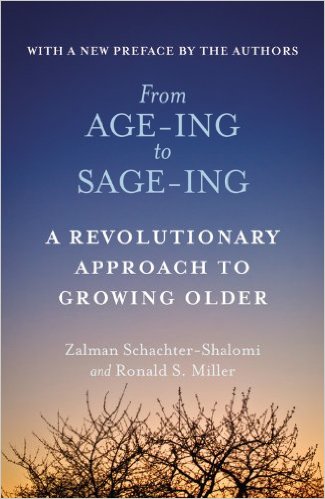 Over two decades ago, beloved and respected rabbi Zalman Schachter-Shalomi felt an uneasiness. He was growing older, and fears about death and infirmity were haunting him. So he decided to embark on mission to get to the bottom of his fears. Through a series of events that included a vision quest in a secluded cabin and studying with Sufi masters, Buddhist teachers and Native-American shamans, Reb Zalman found a way to turn aging into the most meangful and joyous time in his life.
Over two decades ago, beloved and respected rabbi Zalman Schachter-Shalomi felt an uneasiness. He was growing older, and fears about death and infirmity were haunting him. So he decided to embark on mission to get to the bottom of his fears. Through a series of events that included a vision quest in a secluded cabin and studying with Sufi masters, Buddhist teachers and Native-American shamans, Reb Zalman found a way to turn aging into the most meangful and joyous time in his life.
In this inspiring and informative guide, Reb Zalman shares his wisdom and experience with readers. He shows readers how to create an aging process for themselves that is full of adventure, passion, mystery, and fulfillment, rather than anxiety. Using scientific research–both neurological and psychological– Reb Zalman offers techniques that will expand horizons beyond the narrow view of “the present” into a grand and enduring eternity. By harnessing the power of the spirit, as well as explaining exactly how to become a sage in their own community, he gives readers a helpful and moving way to use their own experiences to nurture, heal, and perhaps even save a younger generation from the prison of how we typically regard aging.
In this updated version of his popular book, Reb Zalman has added a brand new introductory chapter that provides insight into the shifts that have taken place in our culture since the first edition of this book came out in the 1990s. Reb Zalman speaks candidly about the role the 78 million (now aging) Baby Boomers are currently playing in how we think about aging. He provides new inspiring ideas about the importance of an elder’s role in shaping society, and explains how elders can embrace the power they have to provide value and wisdom to those around them. Additionally he has added a concluding chapter in which he shares his own experience with aging and the time he calls “The December Years.”
